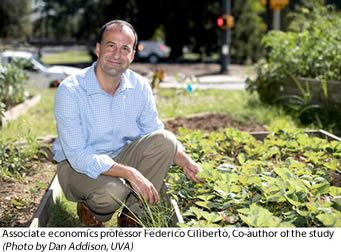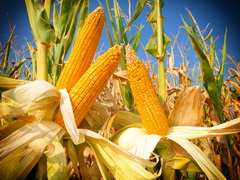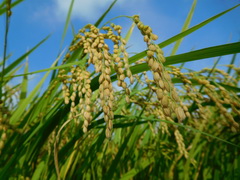 University of Virginia economics professor Federico Ciliberto leads the largest-ever study of the environmental impacts of genetically modified (GM) crops in the U.S.
University of Virginia economics professor Federico Ciliberto leads the largest-ever study of the environmental impacts of genetically modified (GM) crops in the U.S. CROP BIOTECH UPDATE
---------------------------------------------------------------------------
A weekly summary of world developments in agri-biotech for developing countries, produced by the Global Knowledge Center on Crop Biotechnology, International Service for the Acquisition of Agri-biotech Applications SEAsiaCenter (ISAAA)
---------------------------------------------------------------------------
September 21, 2016
In This Week’s Issue:
News
Africa
• Calestous Juma's New Book Explains Why Humans Resist Tech Innovations like Biotech
Americas
• Largest-Ever Study of GM Crops Reveals their Environmental Impacts
• Maize Genetics Helps Scientists Study Crop Adaptation to Climate Change
Asia and the Pacific
• Australian OGTR Invites Comments for Field Trial of GM Indian Mustard
• OGTR Issues New Application Form for Commercial Release of GM Plants
• USDA GAIN Releases Philippine Biotechnology Update
• FAO to Conduct Agricultural Censuses in Asia to Help Achieve SDGs
Europe
• European Commission Approves Syngenta GM Maize
Research
• Transcription Factor ONAC095 Plays Opposite Roles in Drought and Cold Tolerance in Rice
• Plant Defensin from Legume Confers Resistance to Leaf Rust in Wheat
New Breeding Technologies
• Researchers Enhance Rice Blast Resistance via CRISPR/Cas9-Targeted Mutagenesis of OsERF922
Beyond Crop Biotech
• Scientists Search for Alternative Sources of Vanilla Flavor
Document Reminders
• Proceedings of the 2016 FAO International Symposium on Agricultural Biotechnologies
• Download the Updated Pocket Ks on Biotech
----
NEWS
----
Africa
CALESTOUS JUMA'S NEW BOOK EXPLAINS WHY HUMANS RESIST TECH INNOVATIONS LIKE BIOTECH
Harvard University Professor Calestuos Juma examined why people oppose new technologies such as biotechnology in his new book Innovation and Its Enemies: Why People Resist New Technologies.
Some of the chapters of the book discuss issues surrounding GMOs such as transgenic crops and GE salmon. According to Juma, people do not actually despise innovation because of its novelty, but because it introduces something that will disrupt their way of life. Innovation also has the tendency to detach people from nature or their sense of purpose, which are vital to human experience.
Juma's idea of writing the book started in the late 1990s when he witnessed international negotiations on GM crops regulation. He listened to the arguments of opposing groups and realized that even if they have polarized views, they both have a common goal.
Get a copy of the book from Oxford University Press. Read more about the book from Genetic Literacy Project and The Washington Post.
 University of Virginia economics professor Federico Ciliberto leads the largest-ever study of the environmental impacts of genetically modified (GM) crops in the U.S.
University of Virginia economics professor Federico Ciliberto leads the largest-ever study of the environmental impacts of genetically modified (GM) crops in the U.S.
Alongside Edward D. Perry of Kansas State University, David A. Hennessy of Michigan State University, and Gian Carlo Moschini of Iowa State University, the four economists studied annual data from more than 5,000 soybean and 5,000 maize farmers in the U.S. from 1998 to 2011, exceeding previous studies that have been limited to one or two years of data.
The study found that maize farmers who planted insect resistant seeds used significantly less insecticide (about 11.2 percent less) than farmers who did not use GM maize; and that they also used 1.3 percent less herbicides over the 13-year period. On the other hand, adopters of GM soybean used 28 percent more herbicides than non-adopters.
For more details, read the news release at the University of Virginia website.
 Scientists from the University of California Davis are leading a new project to study the genetic adaptation of maize to different environmental conditions. The team is looking at the genetic basis of maize adaptation to high-elevation environments, to find out how wild and domesticated maize populations adapt to new climates.
Scientists from the University of California Davis are leading a new project to study the genetic adaptation of maize to different environmental conditions. The team is looking at the genetic basis of maize adaptation to high-elevation environments, to find out how wild and domesticated maize populations adapt to new climates.
The researchers are comparing agronomic and genetic traits of maize varieties from high and low elevations, using traditional wild and domestic landraces from different environments. They are also studying population genetics in teosinte, to see how teosinte is adapted to these different conditions.
The research team is using maize to study plant adaptation for crop improvement because it is widely planted and highly adaptable to different environments around the world. They are also taking advantage of the large amount of knowledge and resources for studying maize genetics.
For more details, read the news release at the UC Davis website.
The Australian Office of the Gene Technology Regulator (OGTR) invites comments from the public to assess license application DIR 149 from Nuseed Pty Ltd for a field trial of genetically modified (GM) Indian mustard.
The trial is proposed to take place between April 2017 and May 2022, with trial sites selected from 99 possible local government areas in New South Wales, Victoria, and Queensland. The trial would be subject to control measures that restrict the spread and persistence of the GM plants and their introduced genetic material. The GM Indian mustard would not be used for human food or animal feed.
The Gene Regulator is preparing a Risk Assessment and Risk Management Plan for the application to be released for public comment and advice from experts, agencies, and authorities in November 2016.
For more details, read the DIR 149 documents available at the OGTR website.
Australia's Office of the Gene Technology Regulator (OGTR) has issued a new application form specifically for the commercial release of genetically modified (GM) plants: Application for a licence for dealings involving intentional release (DIR) of GM plants into the environment – commercial release.
The new form allows science-related questions to be tailored to the specific information required for risk analysis of commercial releases of GM plants. Additionally, the new form provides links to possible answers to assist with completing the form and illustrate the kind of information required.
For more details, visit the OGTR website.
The USDA Global Agricultural Information Network released an update of the current status of biotechnology in the Philippines. The report highlights the final ruling issued by the Philippine Supreme Court on August 18, 2016, which reversed its December 8, 2015 decision to stop the field testing, propagation, commercialization, and importation of GE products in the country. The final ruling also validated the new Join Department Circular (JDC), replacing the Administrative Order No. 8 of the Department of Agriculture. According to the report, the delays in the process of biosafety applications brought about by the changes in regulation may cause interruption in the delivery and utilization of important feed ingredients imported from other countries and hinder the competitiveness of Philippine livestock and poultry industries.
Read the Philippine Biotechnology Update from USDA GAIN.
The European Commission on September 16, 2016, has authorized the placing on the market of products containing, consisting of, or produced from genetically modified (GM) maize Bt11 x MIR162 x MIR604 x GA21, four related GM maizes combining three different single GM events (Bt11 × MIR162 × MIR604, Bt11 × MIR162 × GA21, Bt11 × MIR604 × GA21, MIR162 × MIR604 × GA21), and six related GM maize combining two different single GM events (Bt11 × MIR162, Bt11 × MIR604, Bt11 × GA21, MIR162 × MIR604, MIR162 × GA21 and MIR604 × GA21). These events had gone through a full authorization procedure, including a favorable scientific assessment by the European Food Safety Authority (EFSA).
The approved GM events had received "no opinion" vote from the Member States in both the Standing and Appeal Committees, and the Commission decided to adopt this pending decision. The authorization does not cover cultivation, valid for 10 years, and any products from these GM events will be subject to the prescribed strict labelling and traceability rules of the EU.
For more information, read the news release at the European Commission website.
Some NAC transcription factors play crucial roles in abiotic stress response. The team of Lei Huang from Zhejiang University in China recently characterized a rice stress-responsive NAC gene, ONAC095, and explored its role in drought and cold stress tolerance.
The expression of ONAC095 was found to be upregulated by drought stress and abscisic acid (ABA), but was downregulated by cold stress. Two transgenic rice lines, one overexpressing ONAC095 (ONAC095-OE) and another with a suppressed ONAC095 (ONAC095-SRDX), were generated. The ONAC095-OE plants showed comparable phenotype to wild types under drought and cold stress conditions.
On the other hand, the ONAC095-SRDX plants exhibited an enhanced drought tolerance, but also exhibited a decrease in cold tolerance. Furthermore, ONAC095-SRDX plants showed an increased ABA sensitivity, contained an elevated ABA level, and displayed altered expression of ABA biosynthetic and metabolic genes.
Functional analyses of ONAC095 demonstrate that the gene plays opposite roles in drought and cold stress tolerance. The gene negatively regulates drought response, but positively regulates cold response in rice.
For more information, read the full article in BMC Plant Biology.
 Leaf rust caused by fungus Puccinia triticina (Pt) is known as an economically important disease of wheat globally, causing up to 50 percent yield loss. For the past years, producers used resistant wheat cultivars to control the disease, but genetic resistance lasts only for a short time and breaks down with the arrival of new virulent Pt strains. Thus, Jagdeep Kaur of Donald Danforth Plant Science Center and colleagues developed a transgenic wheat with durable resistance to leaf rust.
Leaf rust caused by fungus Puccinia triticina (Pt) is known as an economically important disease of wheat globally, causing up to 50 percent yield loss. For the past years, producers used resistant wheat cultivars to control the disease, but genetic resistance lasts only for a short time and breaks down with the arrival of new virulent Pt strains. Thus, Jagdeep Kaur of Donald Danforth Plant Science Center and colleagues developed a transgenic wheat with durable resistance to leaf rust.
The scientists transformed two wheat genotypes with a gene coding for antifungal plant defensin (MtDEF4.2) from legume Medicago truncatula. Transgenic lines expressing MtDEF4.2 were characterized and found that the transformation did not affect the root colonization of a beneficial arbuscular mycorrhizal fungus Rhizophagus irregularis.
The results of the study confirmed that expression of MtDEF4.2 in wheat can combat leaf rust without having negative effects on its symbiotic relationship with beneficial mycorrhizal fungus.
Read the research article in Transgenic Research.
 Sequence-specific nucleases (SSNs) have known to be powerful tools for crop improvement, with CRISPR/Cas9 being thought to be the most effective. A team of researchers from Guangxi University, the Chinese Academy of Agriculture Sciences and the South China Agricultural University report on the improvement of rice blast resistance by targeting the OsERF922 gene in rice using CRISPR/Cas9 SSN (C-ERF922).
Sequence-specific nucleases (SSNs) have known to be powerful tools for crop improvement, with CRISPR/Cas9 being thought to be the most effective. A team of researchers from Guangxi University, the Chinese Academy of Agriculture Sciences and the South China Agricultural University report on the improvement of rice blast resistance by targeting the OsERF922 gene in rice using CRISPR/Cas9 SSN (C-ERF922).
Twenty-one C-ERF922-induced mutants with various mutations at the target site were generated. All of the C-ERF922-induced allele mutations were also found to be transmitted to subsequent generations. From these, six T2 homozygous mutant lines were examined for blast resistance and agronomic traits.
All six mutant lines exhibited decreased blast lesions following pathogen infection compared with wild-types. In addition, no significant differences between the six mutant lines and the wild-type plants were detected. These results indicate that CRISPR/Cas9 can be a useful approach for enhancing blast resistance in rice.
For more information on this study, read the full article in Public Library of Science.
 The proceedings of the international symposium "The role of agricultural biotechnologies in sustainable food systems and nutrition" organized by the Food and Agriculture Organization of the United Nation (FAO) on February 15-17, 2016 are now available. The 284-page proceedings, edited by J. Ruane, J.D. Dargie and C. Daly, have eight chapters covering the main highlights of the symposium.
The proceedings of the international symposium "The role of agricultural biotechnologies in sustainable food systems and nutrition" organized by the Food and Agriculture Organization of the United Nation (FAO) on February 15-17, 2016 are now available. The 284-page proceedings, edited by J. Ruane, J.D. Dargie and C. Daly, have eight chapters covering the main highlights of the symposium.
The proceedings can be downloaded as a single document (2.6 MB) or by single chapters on the FAO website.
Updated versions of the following Pocket Ks are now available for download:
Pocket Ks are Pockets of Knowledge, packaged information on crop biotechnology products and related issues produced by the Global Knowledge Center on Crop Biotechnology. These publications are written in easy to understand style and downloadable as PDF for easy sharing and distribution. Other topics are also available at the ISAAA website.